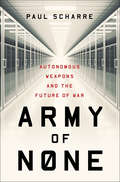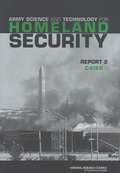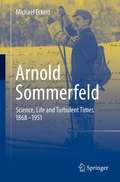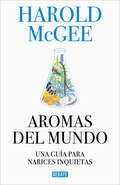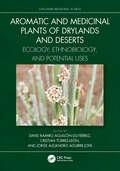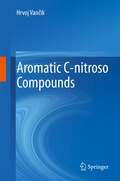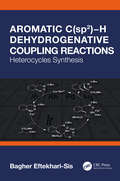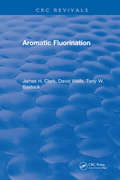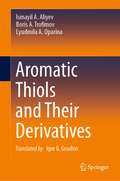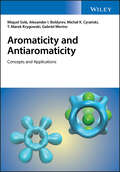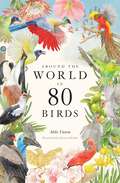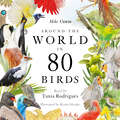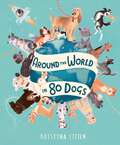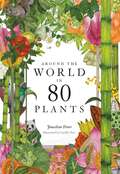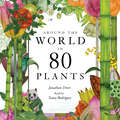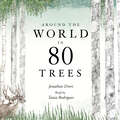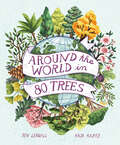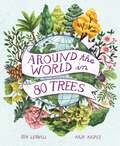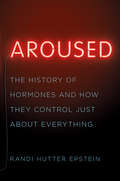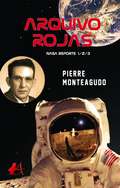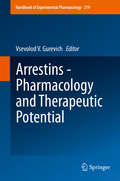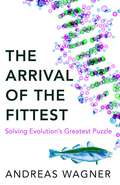- Table View
- List View
Army of None: Autonomous Weapons And The Future Of War
by Paul ScharreA Pentagon defense expert and former U.S. Army Ranger explores what it would mean to give machines authority over the ultimate decision of life or death. <P><P> What happens when a Predator drone has as much autonomy as a Google car? Or when a weapon that can hunt its own targets is hacked? Although it sounds like science fiction, the technology already exists to create weapons that can attack targets without human input. Paul Scharre, a leading expert in emerging weapons technologies, draws on deep research and firsthand experience to explore how these next-generation weapons are changing warfare. <P><P> Scharre’s far-ranging investigation examines the emergence of autonomous weapons, the movement to ban them, and the legal and ethical issues surrounding their use. He spotlights artificial intelligence in military technology, spanning decades of innovation from German noise-seeking Wren torpedoes in World War II—antecedents of today’s homing missiles—to autonomous cyber weapons, submarine-hunting robot ships, and robot tank armies. Through interviews with defense experts, ethicists, psychologists, and activists, Scharre surveys what challenges might face "centaur warfighters" on future battlefields, which will combine human and machine cognition. We’ve made tremendous technological progress in the past few decades, but we have also glimpsed the terrifying mishaps that can result from complex automated systems—such as when advanced F-22 fighter jets experienced a computer meltdown the first time they flew over the International Date Line. <P><P>At least thirty countries already have defensive autonomous weapons that operate under human supervision. Around the globe, militaries are racing to build robotic weapons with increasing autonomy. The ethical questions within this book grow more pressing each day. To what extent should such technologies be advanced? And if responsible democracies ban them, would that stop rogue regimes from taking advantage? At the forefront of a game-changing debate, Army of None engages military history, global policy, and cutting-edge science to argue that we must embrace technology where it can make war more precise and humane, but without surrendering human judgment. When the choice is life or death, there is no replacement for the human heart.
Army Science And Technology For Homeland Security: Report 2
by Committee on Army Science Technology for Homeland Defense--C4ISRShortly after the events of September 11, 2001, the U.S. Army asked the National Research Council (NRC) for a series of reports on how science and technology could assist the Army meet its Homeland defense obligations. The first report, Science and Technology for Army Homeland Security—Report 1, presented a survey of a road range of technologies and recommended applying Future Force technologies to homeland security wherever possible. In particular, the report noted that the Army should play a major role in providing emergency command, control, communications, computers, intelligence, surveillance, and reconnaissance (C4ISR) capabilities and that the technology and architecture needed for homeland security C4ISR was compatible with that of the Army’s Future Force. This second report focuses on C4ISR and how it can facilitate the Army’s efforts to assist the Department of Homeland Security (DHS) and emergency responders meet a catastrophic event.
Arnold Sommerfeld: Science, Life and Turbulent Times 1868-1951
by Michael EckertThe subject of the book is a biography of the theoretical physicist Arnold Sommerfeld (1868-1951). Although Sommerfeld is famous as a quantum theorist for the elaboration of the semi-classical atomic theory (Bohr-Sommerfeld model, Sommerfeld's fine-structure constant), his role in the history of modern physics is not confined to atoms and quanta. Sommerfeld left his mark in the history of mathematics, fluid mechanics, a number of physical subdisciplines and, in particular, as founder of a most productive "school" (Peter Debye, Wolfgang Pauli, Werner Heisenberg, Linus Pauling and Hans Bethe were his pupils, to name only the Nobel laureates among them). This biography is to a large extent based on primary source material (correspondence, diaries, unpublished manuscripts). It should be of particular interest to students who are keen to know more about the historical roots of modern science. Sommerfeld lived through turbulent times of German history (Wilhelmian Empire, Weimar Republic, Nazi period). His life, therefore, illustrates how science and scientists perform in changing social environments. From this perspective, the biography should also attract readers with a general interest in the history of science and technology.
Aromas del mundo: Una guía para narices inquietas
by Harold McGeeUn viaje al misterioso mundo de los olores con Harold McGee, autor de La cocina y los alimentos. En esta obra de asombrosa sabiduría y originalidad, Harold McGee destila la ciencia que hay detrás de los olores hasta obtener una guía accesible y muy entretenida sobre los aromas del mundo. Aunando vivencias personales y una rigurosa investigación, incorpora los últimos descubrimientos de la biología y la química, y revela cómo nuestro olfato, un sentido con una poderosa pero ignorada influencia en nuestra vida cotidiana, tiene el poder de exponer detalles invisibles e intangibles del mundo material, y provocar sensaciones extraordinarias. Remontándose a los orígenes de los olores en el espacio interestelar, McGee nos cuenta la fascinante historia de las moléculas que desencadenan nuestras percepciones a diario, responsables de fragancias como los aromas cítricos a cilantro y cerveza y los olores medicinalesa narcisos y erizos de mar, muchas de las cuales existían antes de que ninguna criatura pudiera olerlas. Este libro nos lleva en una aventura sensorial en la que olisquearemos lo ordinario (calle mojada y hierba cortada) y lo apetitoso (pan fresco y chocolate), lo delicioso (rosas y vainilla) y lo desagradable (carne en mal estado y huevos podridos), desde la sulfurosa tierra naciente hace más de cuatro mil millones de años hasta las tenues notas de fenol y formaldehído de nuestros teclados de ordenador. McGee rastrea olores de alimentos, bosques, ríos y flores, y nos muestra con su habitual maestría cómo aprender a detectarlos, identificarlos, valorarlos y combinarlos para transformar nuestra relación con la cocina y los sabores. La crítica ha dicho...«Una guía profundamente investigada de los olores del mundo, que capta hasta sus más volátiles moléculas.»The New York Times «Cada página está repleta del equivalente olfativo de las onomatopeyas. No decepcionará a ningún admirador de los ensayos culinarios de McGee.»The Wall Street Journal «El libro de referencia que hará que todo lo que comas parezca más interesante. Hay fascinación y deleite en cada página».The Sunday Times
Aromatic and Medicinal Plants of Drylands and Deserts: Ecology, Ethnobiology, and Potential Uses (Exploring Medicinal Plants)
by David Ramiro Aguillón-Gutiérrez, Cristian Torres-León, and Jorge Alejandro Aguirre-JoyaThe description and analysis of the Mexican and other countries desertic plants from the point of view of their use in traditional medicine and their potential use in integrative medicine is the overall theme of this book. Aromatic and Medicinal Plants of Drylands and Deserts: Ecology, Ethnobiology and Potential Uses describes the historic use of drylands plants, botanical and geological classification, also describes the endemic plants used in traditional medicine, going through the most relevant aspects of biomedicine and integrative medicine. The chemical and bioactive compounds from desertic medicinal and aromatic plants and the analytic techniques to determine chemical and bioactive compounds from the medicinal and aromatic plants are reviewed. Ethnobiology is detailed in the present book as well as the importance of the integrative medicine for the ancient and actual cultures. The book represents an effort to keep the ethnobiological knowledge of communities for the use of traditional desertic plants with the actual analytical techniques to unveil the chemical molecules responsible of the biological or biomedical applications. Features: • Describes the endemic plants used in traditional medicine • Includes the chemical and bioactive compounds from desertic medicinal plants • Addresses the analytic techniques to determine chemical and bioactive compounds • Represents an effort to keep the ethnobiological knowledge of communities To execute this book, there are collaborations by authors from different institutions in northern Mexico, which is where the arid and semi-arid ecosystems of the country are found. Although the subject of medicinal plants has been treated from different angles, this book offers a holistic and comprehensive vision of these important organisms of the Mexican desert, thus resulting in an updated work for specialized readers and for those who are beginning in this exciting theme.
Aromatic C-nitroso Compounds
by Hrvoj VančikThis book is designed to collect and review the research covering main directions in investigations of aromatic nitroso compounds in last decades, and to present both, the academic aspects of this chemistry, as well as the open field of its applicability. The book is divided in five chapters. The basic structural properties of the nitroso aromatic molecules are described in the first chapter. The second chapter is an overview of the methods of preparations of aromatic nitroso and polynitroso compounds, including classical synthetic methods and some new preparative approaches. The third part deals with the physico-chemical properties of nitroso aromates and azodioxides, its structure, crystallography, quantum chemical calculations, spectroscopy, typical reactions, and especially it is focused on the dimerizations in the solid-state. In the fourth chapter is represented organometallic chemistry of nitroso aromatic molecules and its applications in catalysis. The last part of the book deals with the behavior of this class of compounds in the biological systems, reactions with biomolecules and the use in toxicology.
Aromatic C(sp2)−H Dehydrogenative Coupling Reactions: Heterocycles Synthesis
by Bagher Eftekhari-SisThis comprehensive text covers the research and development trends in the growing field of aromatic C–H dehydrogenative coupling reactions, leading to different types of heterocycles. The author provides answers to how these coupling reactions occur, what kinds of heterocycles are synthesized, and what their advantages are. The palladium-, rhodium-, iridium-, copper-, cobalt-, ruthenium-, and ferric-catalyzed aromatic C(sp2)–H dehydrogenative cross-coupling reactions are described in detail. A useful reference source for researchers and graduates in the field of heterocyclic chemistry and transition-metal-catalyzed dehydrogenative coupling reactions. Features: Comprehensive volume on the synthesis of benzo-heterocycles via aromatic C(sp2)–H bond activation. Heterocycles are of paramount importance to medicinal chemistry and drug discovery. Provides a comprehensive literature survey on the construction of heterocycles. Reaction procedures and mechanistic explanations are included, which will appeal to those in fine chemicals and pharmaceutical companies.
Aromatic Fluorination (New Directions In Organic And Biological Chemistry Ser. #8)
by James H. ClarkAcademia and industry join forces in Aromatic Fluorination, as an expert from each domain contributes to this new text on fluorination of carbocyclic and heterocyclic rings. The book begins with a discussion of fluorine's unique combination of properties, including size, electronic effects, and hydrophobicity, as well as the historical development of its product applications. It explains methods for introducing fluorine into an aromatic ring, focusing on nucleophilic fluorine transfer reactions. The role of catalysts, solvents, and other variables are examined, and the scope and limitations of the methods are discussed. Of particular interest to those working in non-specialist laboratories, Aromatic Fluorination includes detailed descriptions of the new electrophilic routes to fluoroaromatics, in addition to traditional routes and alternative methods involving radical chemistry. Because one of the most important fluorine-containing substituent is CF3, the book explains routes to benzotrifluorides (ArCF3), including traditional industrial methods and modern alternatives employing C-1 halofluorocarbons and other fluoroaliphatics. An alternative to CF3 is CF3S, and several methods of synthesizing aromatic CF3S-containing molecules are described. Since the successful development and diverse applications of aromatic fluorine compounds have led to the search for new compounds and novel substituents, the incorporation of other substituents is also explored. Aromatic Fluorination concludes with discussion of the factors responsible for the successful development of pharmaceutical, agrochemical and liquid crystal applications and the potential for applications in high-performance polymers and other areas. This section also describes in detail important industrial aromatic fluorination processes and the relative merits of different process technologies and their costs.
Aromatic Thiols and Their Derivatives
by Ismayil A. Aliyev Boris A. Trofimov Lyudmila A. OparinaThis book is devoted to the synthetic and physical chemistry of aromatic thiols and their closest derivatives, sulfides, sulfoxides, sulfones, including those substituted by various functional groups such as acyl and thioacyl, alkoxide, ester, hydroxyl and halogens. In some cases, for comparison, selenium and oxygen analogues are also detailed. The main focus of the book is on synthetic methods, both traditional and new, based on the use of transition metals as catalysts, as well as the reactivity of the compounds obtained. Its addition to the influence of conformational and electronic factors on spectral (NMR, IR, UV, NQR) and electrochemical characteristics of the compounds is presented. Finally, the book describes the application of aromatic thiols and their derivatives as drug precursors, high-tech materials, building blocks for organic synthesis, analytical reagents and additives for oils and fuels. It is a useful handbook for all those interested in organosulfur chemistry.
Aromaticity and Antiaromaticity: Concepts and Applications
by Miquel Solà Alexander I. Boldyrev Michal K. Cyrañski Tadeusz M. Krygowski Gabriel MerinoAromaticity and Antiaromaticity A comprehensive review of the science of aromaticity, as well as its evolution, from benzene to atomic clusters In Aromaticity and Antiaromaticity: Concepts and Applications, a team of accomplished chemists delivers a comprehensive exploration of the evolution and critical aspects of aromaticity. The book examines the new global criteria used to evaluate aromaticity, including the Nucleus Independent Chemical Shift (NICS) index and the electronic indices based on electronic properties. Additional discussions of inorganic aromatic compounds developed in this century, which give rise to new concepts like multifold aromaticity, are included. Three-dimensional aromaticity found in fullerenes and nanotubes, Möbius aromaticity present in some annulenes, and excited state aromaticity are explored as well. This volume explores the geometrical, electronic, magnetic, and thermodynamic characteristics of aromatic and antiaromatic compounds and their reactivity properties. It also provides: A thorough historical overview of aromaticity, as well as simple electronic and structural models Comprehensive explorations of organic and inorganic aromatic compounds, concepts of stability and reactivity, and geometric, energetic, magnetic, and electronic criteria of descriptors of aromaticity Practical discussions of heteroaromaticity, as well as Möbius aromaticity and excited state aromaticity In-depth examinations of sigma, pi, delta, and phi aromaticity Perfect for graduate students, researchers, and academics interested in aromaticity, organometallic chemistry, and computational chemistry, Aromaticity and Antiaromaticity: Concepts and Applications will also earn a place in the libraries of professionals and researchers working in organic, inorganic, and physical chemistry.
Around the World in 80 Birds
by Mike UnwinThis beautiful and inspiring book tells the stories of 80 birds around the world: from the Sociable Weaver Bird in Namibia which constructs huge, multi-nest 'apartment blocks' in the desert, to the Bar-headed Goose of China, one of the highest-flying migrants which crosses the Himalayas twice a year.Many birds come steeped in folklore and myth, some are national emblems and a few have inspired scientific revelation or daring conservation projects. Each has a story to tell that sheds a light on our relationship with the natural world and reveals just how deeply birds matter to us.
Around the World in 80 Birds
by Mike UnwinThis beautiful and inspiring book tells the stories of 80 birds around the world: from the Sociable Weaver Bird in Namibia which constructs huge, multi-nest 'apartment blocks' in the desert, to the Bar-headed Goose of China, one of the highest-flying migrants which crosses the Himalayas twice a year.Many birds come steeped in folklore and myth, some are national emblems and a few have inspired scientific revelation or daring conservation projects. Each has a story to tell that sheds a light on our relationship with the natural world and reveals just how deeply birds matter to us.
Around the World in 80 Birds
by Mike UnwinThis beautiful and inspiring book tells the stories of 80 birds around the world: from the Sociable Weaver Bird in Namibia which constructs huge, multi-nest 'apartment blocks' in the desert, to the Bar-headed Goose of China, one of the highest-flying migrants which crosses the Himalayas twice a year.Many birds come steeped in folklore and myth, some are national emblems and a few have inspired scientific revelation or daring conservation projects. Each has a story to tell that sheds a light on our relationship with the natural world and reveals just how deeply birds matter to us.
Around the World in 80 Dogs (Around the World in 80 #5)
by Kristyna LittenWhat is the oldest breed of dog? Can dogs sniff out illnesses? Which breed has six toes?Including a stunning central gatefold that opens out to reveal all 80 dog breeds and where they come from, this book is a visual celebration of the huge variety of dogs found across the world, from those you already know and love to those that may surprise you. As the book takes the reader on a journey around the world, it reveals dogs with the most important jobs, breeds with unusual features, record-breaking dogs and more.Focus spreads will explore subjects such as the canine family, dogs' superpower sense of smell, and how dogs became man's best friend.
Around the World in 80 Plants
by Jonathan DroriAn inspirational and beautifully illustrated book that tells the stories of 80 plants from around the globe.In his follow-up to the bestselling Around the World in 80 Trees, Jonathan Drori takes another trip across the globe, bringing to life the science of plants by revealing how their worlds are intricately entwined with our own history, culture and folklore. From the seemingly familiar tomato and dandelion to the eerie mandrake and Spanish 'moss' of Louisiana, each of these stories is full of surprises. Some have a troubling past, while others have ignited human creativity or enabled whole civilizations to flourish. With a colourful cast of characters all brought to life by illustrator Lucille Clerc, this is a botanical journey of beauty and brilliance.'A beautiful celebration of the plants and flowers that surround us and a quiet call to arms for change' The Herald'This charming and beautifully illustrated book takes readers on a voyage of discovery, exploring the many ingenious and surprising uses for plants in modern science and throughout history' Kew Magazine'With beautiful illustrations from Lucille Clerc, this captivating book traverses the globe via plants: nettles in England, mangoes in India and tulips in the Netherlands' Daily Mail
Around the World in 80 Plants
by Jonathan DroriAn inspirational and beautifully illustrated book that tells the stories of 80 plants from around the globe.In his follow-up to the bestselling Around the World in 80 Trees, Jonathan Drori takes another trip across the globe, bringing to life the science of plants by revealing how their worlds are intricately entwined with our own history, culture and folklore. From the seemingly familiar tomato and dandelion to the eerie mandrake and Spanish 'moss' of Louisiana, each of these stories is full of surprises. Some have a troubling past, while others have ignited human creativity or enabled whole civilizations to flourish. With a colourful cast of characters all brought to life by illustrator Lucille Clerc, this is a botanical journey of beauty and brilliance.'A beautiful celebration of the plants and flowers that surround us and a quiet call to arms for change' The Herald'This charming and beautifully illustrated book takes readers on a voyage of discovery, exploring the many ingenious and surprising uses for plants in modern science and throughout history' Kew Magazine'With beautiful illustrations from Lucille Clerc, this captivating book traverses the globe via plants: nettles in England, mangoes in India and tulips in the Netherlands' Daily Mail
Around the World in 80 Plants
by Jonathan DroriAn inspirational and beautifully illustrated book that tells the stories of 80 plants from around the globe.In his follow-up to the bestselling Around the World in 80 Trees, Jonathan Drori takes another trip across the globe, bringing to life the science of plants by revealing how their worlds are intricately entwined with our own history, culture and folklore. From the seemingly familiar tomato and dandelion to the eerie mandrake and Spanish 'moss' of Louisiana, each of these stories is full of surprises. Some have a troubling past, while others have ignited human creativity or enabled whole civilizations to flourish. With a colourful cast of characters all brought to life by illustrator Lucille Clerc, this is a botanical journey of beauty and brilliance.Praise for Around the World in 80 Trees"Beautiful to behold and to read" - THE SUNDAY TIMES"An arboreal odyssey" - NATURE"One of the most quietly beautiful books of the year" - DAILY MAIL"Jonathan Drori's deep-seated love of nature is contagious in this tree-by-tree journey across countries and continents. A book to take your time over" - WIRED"A brilliant blend of science, history, culture and folklore, this interesting and engaging book explores the relationship between people and trees as it circumnavigates the globe.The quietly passionate writing is informative, interesting and quite delightful. The hardback version, which I've got, is one of the best-produced books I've read in years: the formatting is crisp and inviting, the paper is heavy and of high quality, and almost every page includes colour drawings by artist Lucille Clerc that are simply breathtaking. Together, these features make this book a joy to touch, to hold and to read." - FORBES
Around the World in 80 Trees
by Jonathan Drori Lucille Clerc"An arboreal odyssey" - NATURE"One of the most quietly beautiful books of the year" - DAILY MAILDiscover the secretive world of trees in Jonathan Drori's number one bestseller...Bestselling author and environmentalist Jonathan Drori follows in the footsteps of Phileas Fogg as he tells the stories of 80 magnificent trees from all over the globe.In Around the World in 80 Trees, Jonathan Drori uses plant science to illuminate how trees play a role in every part of human life, from the romantic to the regrettable. From the trees of Britain, to India's sacred banyan tree, they offer us sanctuary and inspiration - not to mention the raw materials for everything from aspirin to maple syrup.Stops on the trip include the lime trees of Berlin's Unter den Linden boulevard, which intoxicate amorous Germans and hungry bees alike, the swankiest streets in nineteenth-century London, which were paved with Australian eucalyptus wood, and the redwood forests of California, where the secret to the trees' soaring heights can be found in the properties of the tiniest drops of water.Each of these strange and true tales - populated by self-mummifying monks, tree-climbing goats and ever-so-slightly radioactive nuts - is illustrated by Lucille Clerc, taking the reader on a journey that is as informative as it is beautiful. The book combines history, science and a wealth of quirky detail - there should be surprises for everyone.Perfect for fans of Peter Wohlleben's The Hidden Life of Trees, this new book will certainly whet the appetite of any tree lover to take an around-the-world trip, or simply visit your local botanic garden. The perfect travel guide for nature enthusiasts."An irresistible mix of science, culture, botany, history and vicarious travel" - SYDNEY MORNING HERALD"Reads like a love song to the natural world, brimming with ancient anecdotes contained within the earth" - CULTURE TRIP
Around the World in 80 Trees (Around the World in 80 #3)
by Ben LerwillWhere can you find Methuselah, the oldest tree in the world? Why is the baobab's trunk so fat? Can trees really warn each other that something is about to eat them? Including a stunning central gatefold that opens out to reveal all 80 trees and how they relate to each other, this book is a visual celebration of the huge variety of trees found across the world, from those you know to those you almost certainly don't. As the book takes the reader on a journey around the world, it reveals trees that give us food and medicine, trees with ancient legends, record-breaking trees and more. Focus spreads will explore subjects such as the life cycle of trees, how they communicate with each other, why trees are vital to the Earth's health, and their importance to us.
Around the World in 80 Trees (Around the World in 80 #3)
by Ben LerwillWhere can you find Methuselah, the oldest tree in the world? Why is the baobab's trunk so fat? Can trees really warn each other that something is about to eat them?Including a stunning central gatefold that opens out to reveal all 80 trees and how they relate to each other, this book is a visual celebration of the huge variety of trees found across the world, from those you know to those you almost certainly don't. As the book takes the reader on a journey around the world, it reveals trees that give us food and medicine, trees with ancient legends, record-breaking trees and more.Focus spreads will explore subjects such as the life cycle of trees, how they communicate with each other, why trees are vital to the Earth's health, and their importance to us.
Around the World in 80 Trees (Around the World in 80 #3)
by Ben LerwillJourney around the globe to gaze up at towering redwoods, marvel at monkey puzzles, and find out which tree has fish swimming around its roots. Discover trees that give us beautiful flowers, delicious treats, and life-saving medicines—and bizarre trees with bloodred sap, fruit that can be used as soap, or even burned as candles. Learn how trees communicate with each other and how they helped us journey to the farthest reaches of our world. Bursting with blossom and the rustling of leaves, explore the tallest, the smallest, and everything in between.Includes a stunning central gatefold that opens out to reveal all 80 trees and how they relate to each other. Focus spreads explore subjects such as the life cycle of trees, how they communicate with each other, why trees are vital to the Earth's health, and their importance to us.A visual celebration of the huge variety of trees found across the globe, from those you know to those you almost certainly don't!
Aroused: The History Of Hormones And How They Control Just About Everything
by Randi Hutter EpsteinA guided tour through the strange science of hormones and the age-old quest to control them. Metabolism, behavior, sleep, mood swings, the immune system, fighting, fleeing, puberty, and sex: these are just a few of the things our bodies control with hormones. Armed with a healthy dose of wit and curiosity, medical journalist Randi Hutter Epstein takes us on a journey through the unusual history of these potent chemicals from a basement filled with jarred nineteenth-century brains to a twenty-first-century hormone clinic in Los Angeles. Brimming with fascinating anecdotes, illuminating new medical research, and humorous details, Aroused introduces the leading scientists who made life-changing discoveries about the hormone imbalances that ail us, as well as the charlatans who used those discoveries to peddle false remedies. Epstein exposes the humanity at the heart of hormone science with her rich cast of characters, including a 1920s doctor promoting vasectomies as a way to boost libido, a female medical student who discovered a pregnancy hormone in the 1940s, and a mother who collected pituitaries, a brain gland, from cadavers as a source of growth hormone to treat her son. Along the way, Epstein explores the functions of hormones such as leptin, oxytocin, estrogen, and testosterone, demystifying the science of endocrinology. A fascinating look at the history and science of some of medicine’s most important discoveries, Aroused reveals the shocking history of hormones through the back rooms, basements, and labs where endocrinology began.
ARQUIVO ROJAS NASA REPORTS 1/2/3
by Pierre MonteagudoEsta é a história de uma criança prodígio chamado Hector Rafael que, com base em sua vontade de ferro, se tornou um astrofísico da NASA e um cientista chave na chegada do homem à Lua.
Arrestins - Pharmacology and Therapeutic Potential (Handbook of Experimental Pharmacology #219)
by Vsevolod V. GurevichThis volume describes our current understanding of the biological role of visual and non-visual arrestins in different cells and tissues, focusing on the mechanisms of arrestin-mediated regulation of GPCRs and non-receptor signaling proteins in health and disease. The book covers wide range of arrestin functions, emphasizing therapeutic potential of targeting arrestin interactions with individual partners.
The Arrival of the Fittest: Solving Evolution's Greatest Puzzle
by Andreas WagnerWe all know about natural selection and the so-called survival of the fittest, which governs how evolution preserves useful adaptations in each subsequent generation of a species. Unfortunately, random change alone could not have produced life as we know it - the maths don't add up, according to cutting-edge research by Andreas Wagner in the revolutionary field of computational biology.In the last decade, Wagner has detected the biological networks guiding the creation of innovation. His investigations of the genes of everything from bacteria to humans is rewriting our understanding of how exactly evolution works and providing insights into the origins of creativity, with lessons that can be applied far beyond genomes.In The Arrival of the Fittest, Wagner delivers a breathtaking new look at our origins, from the genes up.
